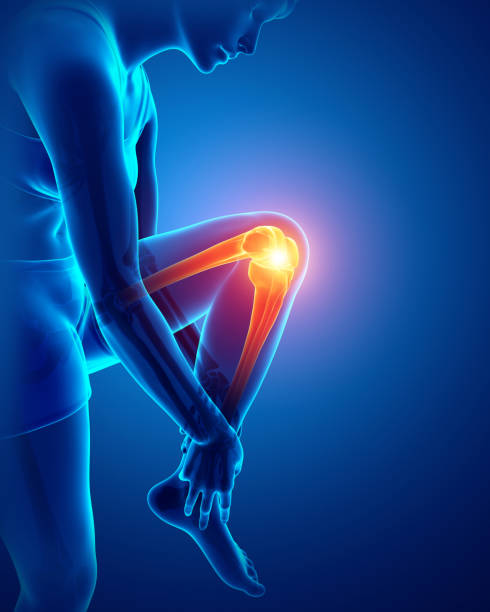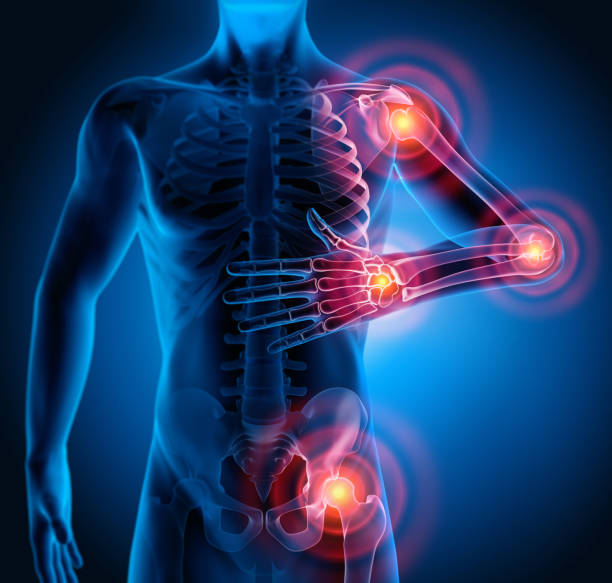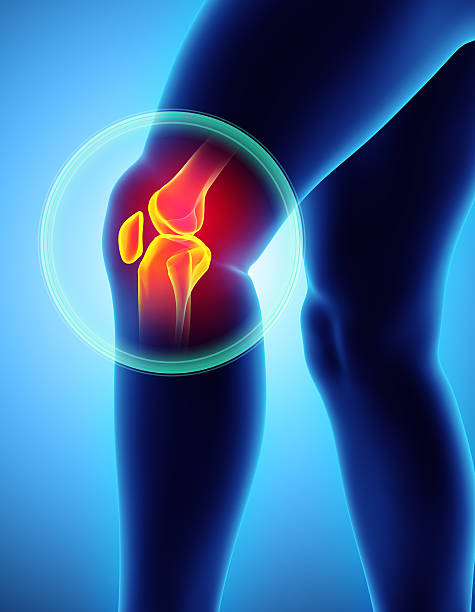Joint Health
Why Does Joint Pain Move Around The Body?
Joint pain, which affects people of all ages and genders, may be a frustrating and painful illness. One of the most confounding elements of joint pain is that it can spread throughout the body, making it impossible to pinpoint the cause of the agony. This is referred to as migratory arthritis, and it can be caused by a number of circumstances.
Migratory arthritis is defined by pain that shifts from one joint to the next. For people who suffer from the disease, this can be a perplexing and unpleasant experience because the pain appears to come and go with no clear pattern. While migratory arthritis can afflict men and women of any age, it is most common in people over the age of 40.
A variety of variables can contribute to the development of migrating arthritis. Underlying medical disorders such as lupus, gout, osteoarthritis, and rheumatoid arthritis, as well as lifestyle factors such as diet and exercise habits, can all contribute to this. Understanding the underlying causes of migratory arthritis allows us to manage the condition and lessen its impact on our lives.

Joint Pain and Its Causes
Joint pain is a widespread issue that affects millions of individuals worldwide. A number of things can contribute to it, including arthritis, injury, infection, inflammation, and chronic diseases. We’ll go over some of the most prevalent reasons of joint discomfort in this section.
Arthritis
Arthritis is a term used to describe joint inflammation. It can be classified into several forms, including osteoarthritis, rheumatoid arthritis, and lupus. The most prevalent type of arthritis is osteoarthritis, which is caused by joint wear and tear over time. Lupus and rheumatoid arthritis are autoimmune diseases that lead the immune system to attack the joints.
Gout
Gout is a kind of arthritis characterized by uric acid accumulation in the joints. This can result in severe episodes of joint pain, swelling, and redness.
Injury
Another major reason of joint discomfort is injury. Sprains, strains, and fractures are examples of such injuries. Accidents, sports, and other physical activities can all result in injuries.
Infection
Joint pain can also be caused by infection. Infections caused by bacteria, viruses, or other microbes are examples of this. Lyme disease and rheumatic fever are two illnesses that can cause joint pain.
Inflammation
Inflammation is a normal immune system reaction to damage or illness. Chronic inflammation, on the other hand, can cause joint pain and damage over time. Chronic inflammation can be caused by a variety of illnesses, including inflammatory bowel disease and hepatitis.
In conclusion, joint pain can be caused by a number of variables such as arthritis, injury, infection, inflammation, and chronic illnesses. If you have significant joint discomfort that lasts for an extended period of time, you should seek medical assistance.

Symptoms and Diagnosis
Joint pain that moves across the body can indicate a variety of medical issues. Identification of joint pain can be difficult because it manifests differently depending on the underlying reason. People do, however, suffer certain common symptoms.
Identifying Joint Pain
Joint pain is characterized by discomfort or pain in one or more joints. Pain can be minor to severe, and it can be acute or persistent. Redness, swelling, stiffness, and warmth around the damaged joint are the most frequent signs of joint pain.
Joint discomfort might be accompanied by additional symptoms such as fever, rash, or joint swelling in rare cases. If you have any of these symptoms, you should consult a doctor for a medical evaluation.
Medical Examination
When you go to see a doctor about joint discomfort, they will usually begin by taking your medical history and completing a physical examination. The doctor will look for symptoms of joint inflammation, such as redness, swelling, and warmth, during the examination. A range of motion test may also be performed to measure the extent of joint mobility.
To gain a better look at the bones and joints, the doctor may prescribe diagnostic tests such as an X-ray or an MRI. These tests can assist the doctor in identifying any underlying issues that may be causing joint pain.
In conclusion, moving joint pain can be an indication of a variety of medical disorders. If you have joint discomfort, you should consult a doctor for a medical checkup to establish the underlying cause.

Treatment and Management
There are various treatment options available for migratory arthritis. Migratory arthritis is often treated and managed with medication, treatment, and lifestyle changes. Some of the most prevalent ways are as follows:
Medication and Therapy
Migratory arthritis symptoms can be managed with medication and therapy. Nonsteroidal anti-inflammatory medicines (NSAIDs) like ibuprofen and naproxen can aid with pain and inflammation relief. Corticosteroids may be administered in rare circumstances to assist reduce inflammation and pain. Disease-modifying antirheumatic medications (DMARDs) can also be used to halt disease progression.
Physical therapy can also aid with the management of migratory arthritis. A physical therapist can assist you in developing an exercise program that is specific to your needs. This can aid in the improvement of mobility, flexibility, and strength. Occupational therapy may be indicated in some circumstances to assist you learn how to conduct daily activities with less pain.
Lifestyle Changes
Changes in lifestyle can also help manage the symptoms of migratory arthritis. Rest is essential for reducing pain and inflammation. However, it is also critical to keep active and exercise on a regular basis. Swimming and cycling are two low-impact exercises that can assist increase joint mobility and minimize pain.
Maintaining a healthy diet and weight might also aid in the management of migratory arthritis symptoms. A diet high in fruits and vegetables, as well as whole grains, can help reduce inflammation and enhance general health. Losing weight can also help minimize joint strain and improve mobility.
In addition to these lifestyle modifications, it is critical to follow other health suggestions for better health management. This includes getting enough sleep, controlling stress, and not smoking or drinking too much alcohol.
Surgery may be required in some circumstances to treat the symptoms of migratory arthritis. Joint replacement surgery or other procedures to repair or replace damaged joints may be required. Remission may be feasible in some circumstances with adequate therapy and supervision.
Overall, there are numerous treatment choices for migratory arthritis. You can help control your symptoms and improve your overall quality of life by working with your healthcare professional and making essential lifestyle adjustments.

Prevention and Health Tips
Joint pain is a painful and debilitating ailment that can have a negative impact on our quality of life. While there is no definite technique to prevent joint discomfort from migrating across the body, there are several precautions we may take.
Exercise Regularly
Regular exercise is one of the most effective ways to maintain our joints healthy and prevent joint discomfort from spreading throughout the body. Exercise strengthens the muscles around our joints, which helps to give greater support and reduces the risk of injury. It also keeps our joints fluid and agile, lowering the chance of stiffness and pain.
Maintain a Healthy Diet
A balanced diet is also essential for preventing joint discomfort from traveling about the body. A diet high in fruits and vegetables, healthy grains, and lean protein can help reduce inflammation in the body, which can lead to joint discomfort. It can also help us maintain a healthy weight, which helps alleviate joint stress.
Consider Weight Loss
Losing weight can help to lessen stress on our joints and prevent joint pain from moving throughout the body if we are overweight or obese. Even a tiny amount of weight loss can help reduce the risk of joint pain and improve our overall health.
Make Lifestyle Changes
Making lifestyle adjustments can also aid in preventing joint discomfort from spreading throughout the body. This includes things like not smoking, drinking less alcohol, and getting enough sleep. These modifications can aid in the reduction of inflammation in the body and the promotion of general wellness.
Stretch and Warm Up Before Exercise
Stretching and warming up prior to activity is critical for avoiding joint pain and damage. This can aid to prepare our muscles and joints for exercise while also lowering our chance of strain or sprain. It is also critical to stretch and cool down after exercising to avoid stiffness and pain.
Consider a Fitness Program
Consider collaborating with a fitness professional or physical therapist to create a workout program personalized to our individual requirements and goals. This can assist in ensuring that we are exercising safely and effectively, as well as preventing joint pain from migrating around the body.
Get a Massage or Take a Warm Bath
A massage or a warm bath can also assist to relieve joint pain and stiffness. Massage can improve blood flow and reduce inflammation in the body, while a warm bath helps relax our muscles and joints.
We can help to lessen the likelihood of joint pain from movement and promote general joint health by following these guidelines.
Recent Research and Advancements
We’re always learning new things about joint pain and how it impacts our bodies. Recent studies have given light on why joint pain can spread throughout the body and how we might treat it.
Arthritis, which is characterized by joint inflammation and discomfort, is one of the most prevalent causes of joint pain. Which can be classified into several forms, including migratory arthritis, reactive arthritis, systemic lupus erythematosus, and sarcoidosis. Each type of arthritis is distinguished by its own set of symptoms and treatment choices.
Joint discomfort can be caused by a variety of reasons, including wear and tear, infections such as streptococcus, and even some drugs, according to recent research. It is critical to determine the underlying cause of joint pain and treat it properly in order to effectively manage it.
Stretching exercises are one promising breakthrough in the treatment of joint discomfort. Stretching can assist to improve flexibility and reduce stiffness, both of which can help to alleviate joint discomfort. Additionally, decreasing weight can assist to relieve joint tension and pain.
Pain drugs can also be beneficial in controlling joint pain, but they must be used as advised by a healthcare expert. Overuse of pain relievers can lead to dependence and other health problems.
In conclusion, new studies and developments have given us a better understanding of joint pain and how to manage it. We can lessen pain and enhance our overall quality of life by diagnosing the underlying cause of joint discomfort and using effective treatment options such as stretching exercises and pain medication.
Conclusion
Personally, I’ve found that embracing a holistic approach to joint health has been a compass in navigating these fluctuations. The ebb and flow of joint pain have become signals for me to pay closer attention, prompting a dialogue with my body rather than seeking a quick fix.
My personal advice for those navigating the twists and turns of joint discomfort is to cultivate a partnership with your body. Listen to its signals, explore diverse approaches, and don’t hesitate to seek guidance from healthcare professionals who can provide tailored insights for your unique journey. Together, let’s embark on a path of discovery and resilience, ensuring that our joint health remains a priority in the tapestry of our well-being.


